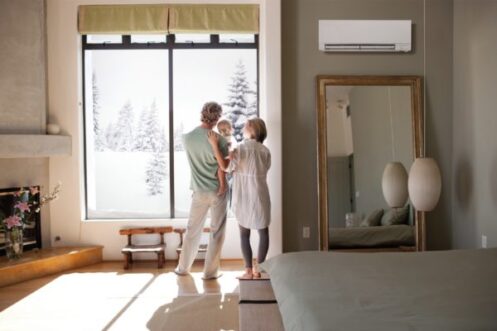
Did you know that the air in your Oak Harbor, WA home could be more contaminated than the air outside? According to the U.S. Environmental Protection Agency (EPA), it could be up to five times more contaminated. While a tightly sealed home envelope promotes HVAC system efficiency, it can also trap many common allergens, pathogens, and gaseous chemical contaminants inside. Read on to find out how your indoor air quality (IAQ) measures up to the quality of air outdoors and learn how to create a healthier living environment.
What Ventilation Does and Why It Matters
In theory, homes should experience a constant inflow of fresh outdoor air along with the release of indoor contaminants through a process known as induction. However, if all building materials are sealed airtight, this essential air exchange doesn’t happen. The “V” in HVAC stands for ventilation, and it’s a critical part of maintaining a healthy home.
All homes have some mechanical ventilation, but yours might not have enough. One of the best ways to create cleaner indoor air is by scheduling an IAQ assessment. Not only will this evaluation list the contaminants present and their concentrations, but it will also point out the need for home additions such as increased ventilation.
Common Sources of Indoor Contaminants
The air outside of your home is constantly moving. This disburses chemical contaminants so that their concentrations become less harmful over time. In comparison, indoor contaminants rarely have a place to go. Some settle on flooring, countertops, and other surfaces, but others circulate throughout buildings indefinitely. Worse still, people in your home and various building materials are always adding new toxins.
Off-Gassing Building Materials
Many building materials constantly off-gas harmful chemicals like benzene, formaldehyde, and other volatile organic compounds (VOCs). While off-gassing tends to be worst during the first one to two years after installation, things like flooring, flooring adhesives, wood composites, and unsealed particle board can add toxins to your home for up to a decade. Each time you apply a fresh coat of paint, refinish your floors or complete other home improvements, off-gassing begins again.
Resident Activities
Even cooking food inside your home adds VOCs to your indoor air. Gaseous chemical contaminants are also released when burning candles, discharging spray cleaners, and using plug-in air fresheners.
However, chemical contaminants are hardly the only IAQ concerns that the average household deals with. When comparing the air inside your home to the air at the building exterior, you should also account for particulate matter, such as:
- Textile fibers
- Carpet fibers
- Pet hair
- Human hair
- Dirt
These things, along with pet dander, pollen, and other airborne debris, can all wreak havoc on the health of building residents.
How Your HVAC Air Filter Helps
HVAC air filters prevent airborne particulate debris from entering HVAC systems and coating their sensitive components like flame sensors, evaporator coils, and more. However, standard air filters have limited surface areas and relatively large filter mesh. Things like mold spores, dust mites, pathogens, and gaseous contaminants flow right through them. Although you can always upgrade your standard air filter for an option with a higher maximum efficiency reporting value (MERV) rating, each increase in filter ratings will create a decrease in airflow throughout your HVAC system.
Integrated HVAC Accessories: Leveraging Innovative IAQ Solutions
For many homes, the most effective and efficient way to improve IAQ is by installing integrated HVAC accessories. These innovative IAQ solutions are installed directly in air ducts or attached to them. They include:
- Air scrubbers
- Whole-house air purifiers
- Whole-house dehumidifiers and humidifiers
- Media filters
- Sanitizing UV lights
Air scrubbers, air purifiers, and sanitizing UV lights deactivate VOCs and other gaseous contaminants, remove 99.7% of airborne particulates measuring as small as 0.3 microns, and eliminate viruses, mold, bacteria, and other harmful pathogens.
In homes with excessively dry or overly moist indoor air, whole-house dehumidifiers and humidifiers make it easier to stave off problems like warped building materials, mold and mildew formation, and unpleasant respiratory symptoms. Media filters offer particulate removal for homes that are heavy with dust, pet hair, and other debris. By scheduling an indoor air quality assessment, you can find out which IAQ solutions are best for you.
Since 1982, we’ve been proudly serving Oak Harbor, WA. We offer expert heating, cooling, and indoor air quality services. We also provide new ductwork and ductless mini-splits. To learn more about improving your home’s IAQ or schedule an IAQ assessment, contact Island Heating & Air Conditioning today.
Tags: HVAC, IAQTags: HVAC
March 28, 2024 4:43 pm

